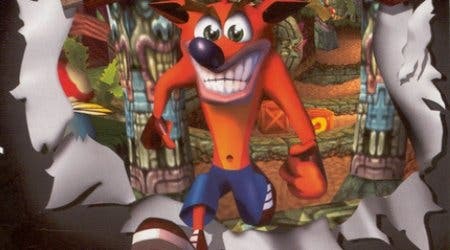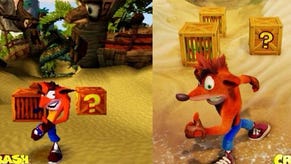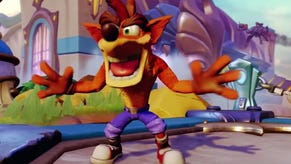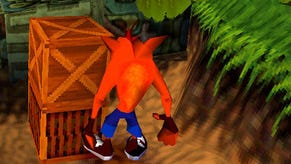Retrospective: Crash Bandicoot
In a spin with the unofficial PlayStation mascot.
They say every cloud has a silver lining, and the rather pointless controversy swirling around Uncharted 3 and the question of linearity in games has had at least one beneficial after effect: it's prompted me to return to Naughty Dog's first big gaming franchise, Crash Bandicoot.
He's furrier than Nathan Drake, a lot less chatty and considerably more orange, but played with the benefit of hindsight, that swashbuckling cartoon marsupial is a closer relation to the cinematic sweep of Uncharted than you might think.
Both games feature a daring hero who ventures deep into hostile and remote locations such as jungles, volcanoes and icy mountains. Each progresses along lushly designed gameplay corridors, A to B obstacle courses where only dexterity and agility prevent both our heroes from meeting grisly fates, as stones crush, walls crumble and bottomless pits yawn open beneath their feet.
Occasionally the camera will sweep around for a different view on the action, be it a traditional side-on run and jump section, a to-camera dash away from some rapidly encroaching threat or a fast-paced vehicle chase (even if the vehicle in question is a warthog).
Admittedly, Crash tends to find his path blocked by skunks and turtles rather than gun-toting henchmen and supernatural creatures, his world more Saturday morning kid's cartoon than blockbuster cliffhanger, but the two heroes are undeniably close cousins in gameplay intent if not aesthetic style.
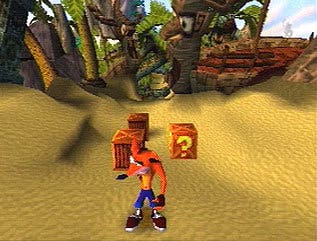
Also like Nathan Drake, Crash Bandicoot debuted as a PlayStation exclusive. Releasing in 1996, only a few months after Mario 64, it was a weird time for the platform game, as decades of perfectly good 2D game design was suddenly junked by the arrival of these strange things called "polygons". With no 2D past to live up to, Crash was particularly well placed to straddle this generational divide.
Perhaps that's why the gameplay is a curious mixture of the old and new. There's nothing particularly innovative in Crash's world - certainly not when compared to Mario's first venture into 3D - yet it still felt like something pretty spectacular for the time.
"Like playing a cartoon" was something of a mantra for the platform genre at the time, and Crash came closer than most with his Looney Tunes gait and rubbery bouncing. What he didn't do was talk, his mute face-pulling a deliberate design choice brought about by Naughty Dog's belief that characters who talked too much were lame. They may have had a point.
In gameplay terms, Crash drew most of his influence not from Mario but from Donkey Kong Country. As the early 3D game code couldn't handle more than a couple of enemies at a time, the empty spaces in each level were filled in with fruit to be collected, and when this distraction proved too shallow, the fruits were hidden inside crates.
Smashing crates to collect stuff is now a cliché in itself, but Naughty Dog did something rather cunning with this nascent trope, using different kinds of crates to create clever little puzzles. Some crates could be bounced on repeatedly to gain more fruit, and to reach other crates hovering in the air. TNT crates would explode if struck, and began a countdown if jumped on. And since Crash's spin attach would knock any unclaimed fruit off the screen for good, there was real skill involved in maximising the, er, fruits of your fruit collecting labour.

Despite its simple exterior, there was a lot more to Crash Bandicoot than dashing to the end of the level. Collecting three matching icons of villains Neo Cortex and Nitrous Brio or Crash's suspiciously sultry girlfriend Tawna would teleport you to a side-on bonus stage, where extra lives could be earned - and lost.
This was no story-driven game where the aim was to hurry you to the next cutscene as painlessly as possible. Despite the cuddly visuals, Crash Bandicoot could be a fearsomely tough game. After a fairly gentle start at N. Sanity Beach, the difficulty ramped up considerably within just a few levels. Not only did the game require precise jumping skills (performed using the d-pad, since this was before the dawn of the analogue sticks) but it often demanded split second reactions as well. Gauntlets of do-or-die leaps and one-hit-kill enemies left little room for timid players to squeak through.
And when you did die, punishment was harsh. Checkpoints were rare, and the game retained enough old school DNA that failure was very much an option. It's been a long time since gamers were faced with a Game Over screen, but Crash Bandicoot - a "kid's game" by today's industry standards - would happily send you back to the menu when those lives ran dry.
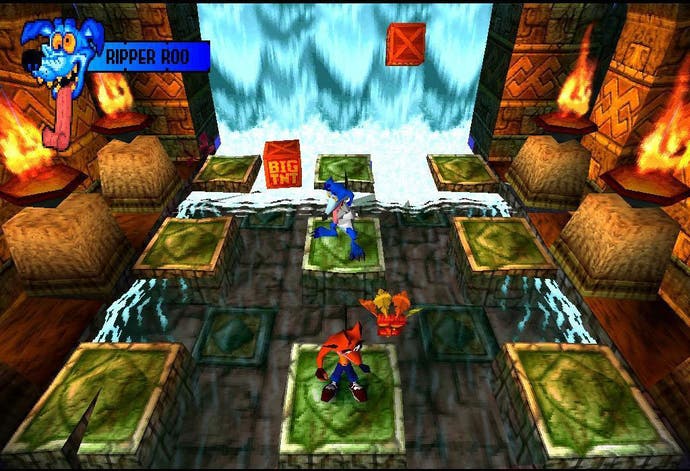
What's most deceptive about Crash is how it rewarded repeat play. Completing a level without losing a life would earn a bonus, while smashing every crate was similarly rewarded. Doing both in the same run was the goal for dedicated players, granting a crystal to prove you'd not just finished a stage, but aced it as well. This would then grant access to new areas, unseen by unworthy gamers. With its emphasis on replay and crate-smashing, there are glimmers of the future Lego games here - so it's perhaps not surprising that Traveller's Tales was the first studio to inherit the series from Naughty Dog once it moved on to Jak and Daxter.
Crash Bandicoot wasn't really inventive enough to leave any lasting mark on his genre but he was certainly more characterful, and his games more polished, than most of his late 90s peers. Naughty Dog stayed with him through two increasingly impressive sequels and the truly fantastic Mario Kart rival Crash Team Racing, but ever since he's been in a sort of slow, quiet decline as popular taste has moved away from anthropomorphic animals and towards the sort of cinematic realism that would lead to Uncharted.
It would be a shame if the forgettable 2008 offering Mind Over Mutant was Crash's last outing. Over the years several studios tried to extricate him from the colourful corridors he'd traversed since 1996, attempting to widen the boundaries of his world and introduce more depth to the gameplay, but they always reverted back to type before the games hit the shelves.
It's a shame, as Crash had the makings of a gaming icon. Maybe not at the sort of level occupied by plumbers and hedgehogs, but for five years he was the default mascot of the original PlayStation and it would be nice to see him brought back for one last lap. Perhaps as a cameo in Uncharted 4...
